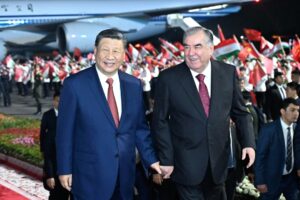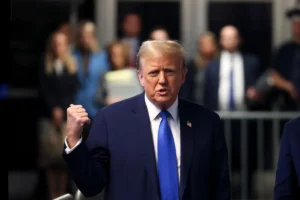Despite having a population of just 2,400, Vevčani has attempted to declare independence from two different countries over the last five decades.
It was Independence Day in the Republic of North Macedonia, a landlocked Balkan country sharing borders with Greece, Albania, Bulgaria, Serbia and Kosovo. Along the northern shores of Lake Ohrid, bright yellow sunbeams of North Macedonian flags fluttered in the breeze that swept down from the Jablanica Mountains as bands played, rakia flowed, and beers were cracked open in celebration of independence from the Socialist Federal Republic of Yugoslavia in 1991.
However, it was coincidence, rather than by design, that my trip coincided with these annual festivities. Instead, I was heading to Vevčani, a fascinating village with its own little-known history of independence.
My bus left the lakeside revelry behind, and we turned into the foothills of the nation’s mountainous western border with Albania. As we entered the village, there were few signs of a party atmosphere. The North Macedonian flag was flying outside the local government building, but it wasn’t alone. Next to it, flew a flag I’d never seen before.
“That’s the flag of the Republic of Vevčani,” said Aleksandra Velkoska, a former tour guide who now works for the Vevčani municipality. “We don’t celebrate independence today. Vevčani has its own independence to celebrate.”
Despite having a population of just 2,400, Vevčani has attempted to declare independence three times from two different countries over the last five decades. In 1987, it first threatened to secede from Yugoslavia. Then, in 1991, the village proclaimed itself to be an independent republic just 11 days after the former Yugoslav Republic of Macedonia (as North Macedonia was previously named) had itself declared independence during the breakup of Yugoslavia. And in 2002, the libertarian spirit of the Republic of Vevčani was revived by locals as a tongue-in-cheek micronation in an unusual effort to draw tourists and poke fun at politics by flying a “national” flag, issuing passports and printing currency.
Vevčani’s independent streak goes back centuries. Although it’s located just a 20-minute drive from Struga, the largest town on Lake Ohrid’s northern shore, the isolated and impenetrable terrain of the Jablanica Mountains ensures that the people of Vevčani have long been able to assert their autonomy.
Vevčani was nominally part of the Macedonian, Roman, Byzantine and Ottoman empires before falling under the jurisdiction of the Kingdom of Serbia, communist Yugoslavia and now North Macedonia. But after meeting me at the bus stop, Velkoska explained that Vevčani was never truly conquered.
“We are very traditional in Vevčani,” Velkoska said, as she guided me up a hill to the Church of St Nicholas. From here, we looked out across the neighbouring villages, where minarets on the surrounding mountain slopes reflected the sunshine. “During the Ottoman era, for example, we kept our culture and our Orthodox religion, even though all of the surrounding villages are Muslim.”
rom the late 14th Century until 1912, the region came under the rule of the Ottoman Empire, which had its capital in what’s now Istanbul. Around 33% of North Macedonia’s population now identifies as Muslim, with the Ottoman legacy being particularly strong in the north-western region that borders Albania and Kosovo (both Muslim-majority countries). Vevčani is effectively an Orthodox Christian enclave in a Muslim-majority area.
The Church of St Nicholas dates to 1824, and beneath the hand-painted murals and frescoes inside, Velkoska introduced me to church caretaker Lambe Shurbanoski, who explained how Vevčani had considerable religious freedoms under the Ottoman Empire.
In The Ottoman Era, You Would Normally Enter A Church by Going Down Steps to Symbolise That Christianity Was Below Islam
As Velkoska guided me further into the village, she explained how Vevčani’s history of non-conformity under Ottoman rule inspired resistance during the communist era that followed World War Two, when the region became part of the Socialist Republic of Macedonia, one of the six republics within Yugoslavia.
“During the communist times, the government tried to stop our traditions,” she said. “They didn’t allow traditional weddings or baptisms, but our mothers and grandmothers still did these things in secret.”
Locals also held onto a unique Slavic dialect found nowhere elsewhere in the country, and each January, the village hosts a 1,400-year-old carnival that draws thousands of visitors from across the Balkans to see revellers dressed up in elaborate costumes and masks.
At the centre of all the village’s unique local customs is the Vevčani springs, which Velkoska took me to see next.
“The springs are the most important part of our culture and history,” she said, as we crossed over a small bridge and followed the riverbank towards the source of Vevčani’s natural spring water. The source was hidden inside a darkened cave, but the entranceway was verdant and green where the spring water flowed into the riverbed. “Almost all celebrations and rites of passage are held here. It’s why people were so annoyed when the Yugoslavian government tried to take our water away.”
In May 1987, the people of Vevčani rose up in protest against the Yugoslavian government’s plans to divert spring water to new villas being built by Lake Ohrid for the communist elite. In response, the village spent that summer building barricades, protesting and threatening to secede as the independent Republic of Vevčani.
The Vevčani Emergency, as it became known, lasted for three months. The government response was heavy handed, and special police armed with batons were sent in to end the uprising. Even so, the government backed down first, and the Vevčani Emergency became one of the first successful instances of mass resistance against the Yugoslavian government. Many of Vevčani’s citizens continued protesting on and off for the next four years in Skopje and Belgrade in an ongoing attempt to hold the authorities accountable for arrests and injuries.
I learned more about the community’s independent streak when we stopped for lunch at Restaurant Kutmicevica. “Do you have a passport?” asked restaurant owner Nasto Bogoeski as we sat down to eat. He wasn’t talking about my British passport and was happy to see that I’d already purchased the red Republic of Vevčani version, complete with a dated entry stamp, from a souvenir stand near the springs.
Bogoeski told me that he was training to be a police officer in Skopje during the Vevčani Emergency. Despite this, he says he was there in spirit, and he’s been involved in supporting the Republic of Vevčani ever since. When he retired from policing in the 2000s, he opened this restaurant, which serves local specialties like gjomleze (a type of slow-cooked pie), sheep’s cheese and grilled vegetables served with a garlic sauce. All are cooked by Vevčani chefs, while Bogoeski regales tourists and travellers with stories of his beloved Republic.
As he poured me a glass of rakia, Bogoeski explained what happened in Vevčani when Yugoslavia began to unravel in the 1990s.
“In 1991, there were referendums for independence all over Yugoslavia,” he said. “In the same moment, the people from Vevčani decided they wanted a referendum for independence. We were politically motivated by everything that had happened during the Vevčani Emergency, and so we also wanted to be separate from Yugoslavia and from [North] Macedonia.”
On 8 September 1991, the Socialist Republic of Macedonia declared independence from Yugoslavia and became the Former Yugoslav Republic of Macedonia. Not content with their new government, on 19 September 1991, the town almost unanimously declared itself an independent republic, with just 36 out of 2,000 locals voting against the motion.
The former Yugoslav Republic of Macedonia never recognised Vevčani’s peaceful bid for independence, but given their government were also dealing with armed separatists in ethnically Albanian regions of the new country, they did eventually concede to demands for autonomy. In 1994, they allowed Vevčani to separate from the larger Struga Municipality and form their own autonomous municipality, which still exists today.
Bogoeski’s daughter, Nikolina, added that in the early 2000s, the rebellious spirit of the village was revived and used to encourage tourism by marketing the Republic of Vevčani as a micronation.
People Across The Balkans Wanted to Know More About The Story Behind Our Flag, Passports and Money
“We made local passports and printed currency to advertise Vevčani,” she said. “It worked, and people across the Balkans wanted to know more about the story behind our flag, passports and money. We have more plans to make a ‘customs post’ at the border to the village, where we can stamp the passports.”
Nikolina also said that, if necessary, the Republic of Vevčani could again become a serious entity in the future. “This is a very political village,” she said. “Our village always comes first. If we held another referendum in the future, I think it would be possible for the village to be independent and stay successful.”
After lunch, Velkoska took me for a sneak peek inside Vevčani’s new museum, which is set to open later this year. Inside, political artworks depicted the Vevčani Emergency and the Republic of Vevčani, alongside a photographic exhibition devoted to Vevčani’s centuries-old carnival. Interestingly, she said, the carnival is effectively a centuries-old satire, because satire is what Vevčani does best. Like its self-appointed micronation status, it’s a way for Vevčani to mock the authorities, and many of the costumes and masks are politically charged, parodying the government or ridiculing recent political events.
Before I caught the bus back to Lake Ohrid, I asked Velkoska whether she thought the Republic of Vevčani was serious or satirical. “Vevčani still has its disagreements with the government,” she said. “But we are too small to be independent. We would have a weak economy. It’s a nice idea, but right now it’s only for fun”.
Source : BBC











